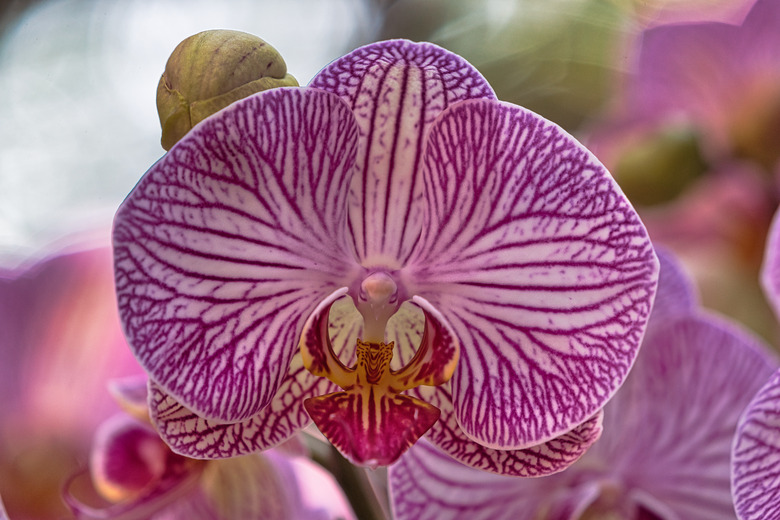Homemade Potting Soil For Orchids
We may receive a commission on purchases made from links.
Numbering more than 25,000 species, according to the University of Vermont Extension, the orchid family (Orchidaceae) is a diverse group of plants, some of which grow attached to trees or rock cliffs, while others grow anchored in the soil. Orchid roots are adapted to their particular growing environment, so proper orchid care includes choosing the right potting medium, which typically doesn't include soil. Epiphytic orchids (those that naturally grow attached to trees or cliffs) grow best in a coarse bark-based or stone potting medium. Terrestrial orchids (those that naturally grow at ground level) grow best in a finer organic medium that mimics the nutrient-rich soil typically found on forest floors.
Although you can purchase commercially packaged orchid growing medium that's suitable for the type of plant you have, you can easily make your own homemade potting mix for orchids. It's important to know what type of orchid you have — epiphytic or terrestrial — so that you'll know which potting medium better serves the growing needs of your plant.
Potting Medium for Epiphytic Orchids
Potting Medium for Epiphytic Orchids
Some of the most common epiphytic orchids in the nursery trade are in the Phalaenopsis genus, commonly called moth orchids because of the way their petals resemble moths. Although these orchids grow as perennials only in the warm climates of U.S. Department of Agriculture plant hardiness zones 10 through 12, they make lovely houseplants. Given proper care, the flowers on moth orchids may persist on plants for four months or more.
A homemade potting mix for moth orchids and other epiphytic orchids is optimally comprised of loose and chunky components, which allow air to circulate freely around the roots and provide good drainage. Tree bark, osmunda tree fern fiber and horticultural lava rock are good choices. One "recipe" for a homemade potting mix includes three parts tree fern fiber and one part redwood bark. Soak the tree fiber in water for at least 12 hours before adding the redwood bark.
Potting Medium for Terrestrial Orchids
Potting Medium for Terrestrial Orchids
Not all orchids are from tropical environments, surviving as perennials only in frost-free climates. Some orchids, such as the Chinese ground orchid (Bletilla striata, USDA zones 5 through 9), are cold-hardy perennials. Ground orchids are, as their name hints, terrestrial plants that naturally grow on soil instead of attached to trees. Their growing medium must drain well, or plants will struggle.
If you're growing terrestrial orchids in the garden, grow them on moist but well-draining soil that's rich in organic matter. If you're growing terrestrial orchids in a container, a suitable potting mix is one that also works for bromeliads. Like orchids, bromeliads are also terrestrial or epiphytic.
Mix equal parts of peat moss, finely shredded pine bark or cypress shavings to make your own potting mix for terrestrial orchids. You can also mix equal parts of peat and pine bark, or you can mix two parts of peat moss, one part of perlite and one part of fir bark.
Care of Orchids
Care of Orchids
Although the proper potting medium is essential for successfully growing orchids, these plants may not thrive or even bloom if other cultural conditions are inadequate. You may have purchased an orchid in bloom or received one as a gift, and it failed to bloom again after the initial spectacular display you enjoyed.
Orchids like humidity, which you can increase around houseplants by setting their pots on top of pebbles in a water-filled tray. Be careful, though, to keep the water level below that of the drainage holes; otherwise, the plants may become waterlogged, and the roots will rot. Most orchids respond best to bright light but not direct sunlight. Place plants in an east or south window or grow your orchids under fluorescent lights.
Keep the well-draining growing medium moist but not soggy and use a water-soluble orchid fertilizer according to all label directions. Generally, you'll fertilize your orchids during the active growing season and reduce or eliminate fertilization during the rest period after blooming ceases. Careful attention to these cultural needs optimizes orchid health and promotes blooming of the exotic flowers for which these plants are prized.
